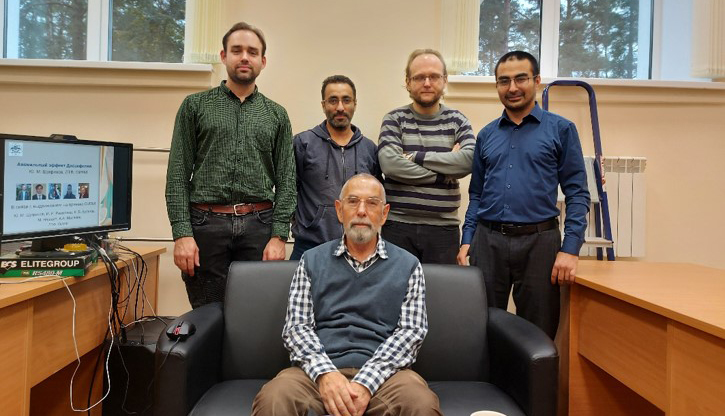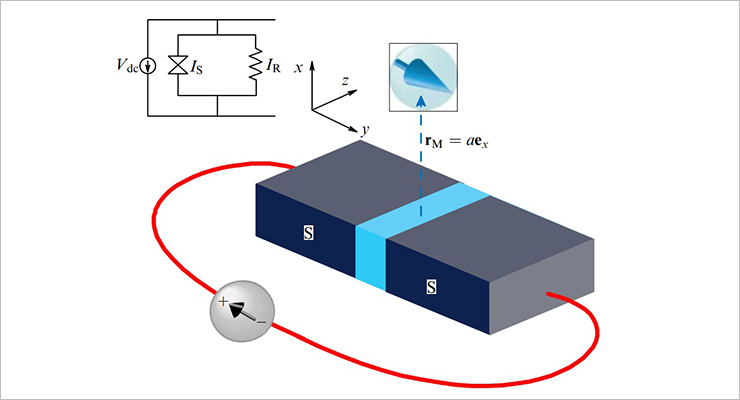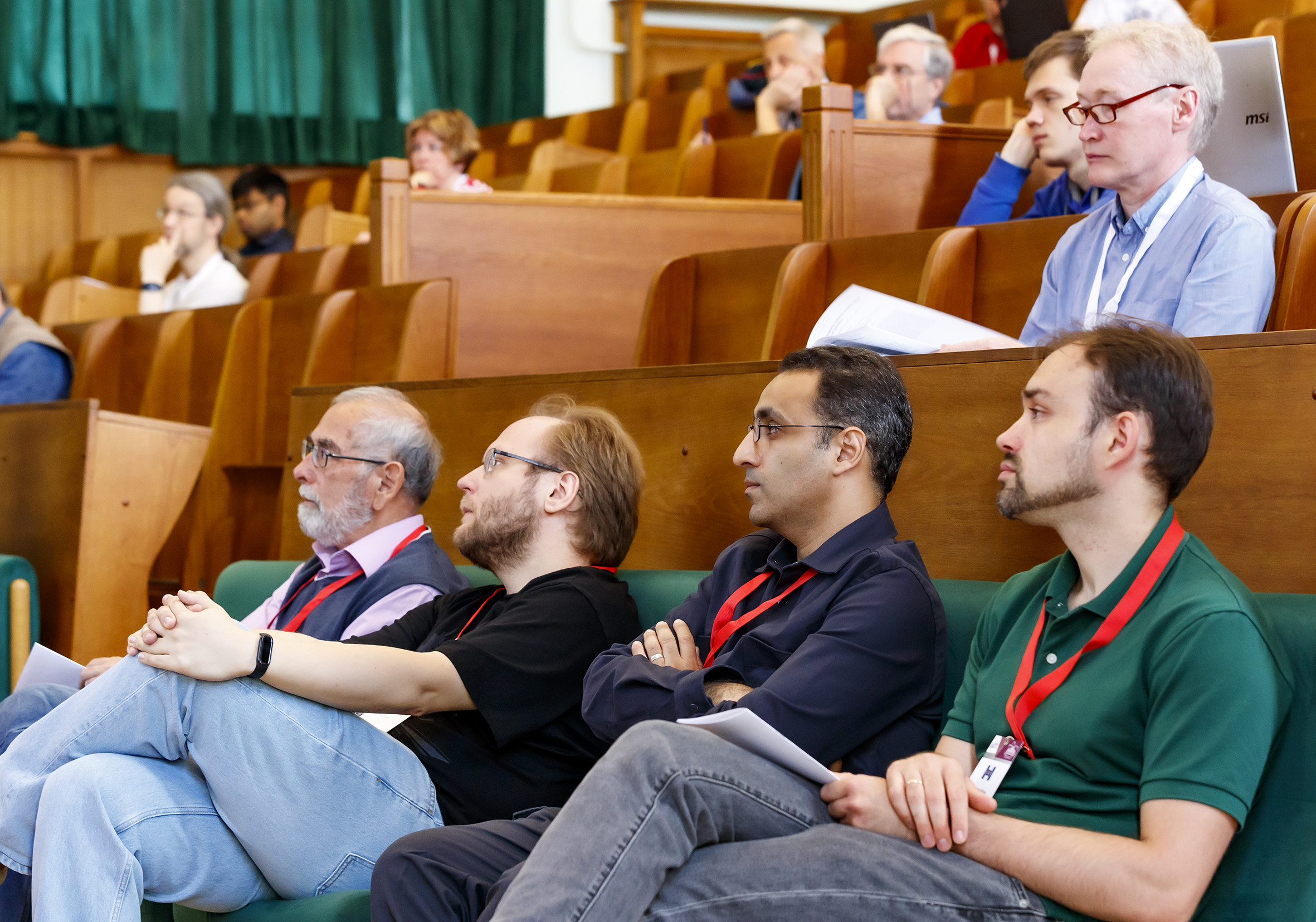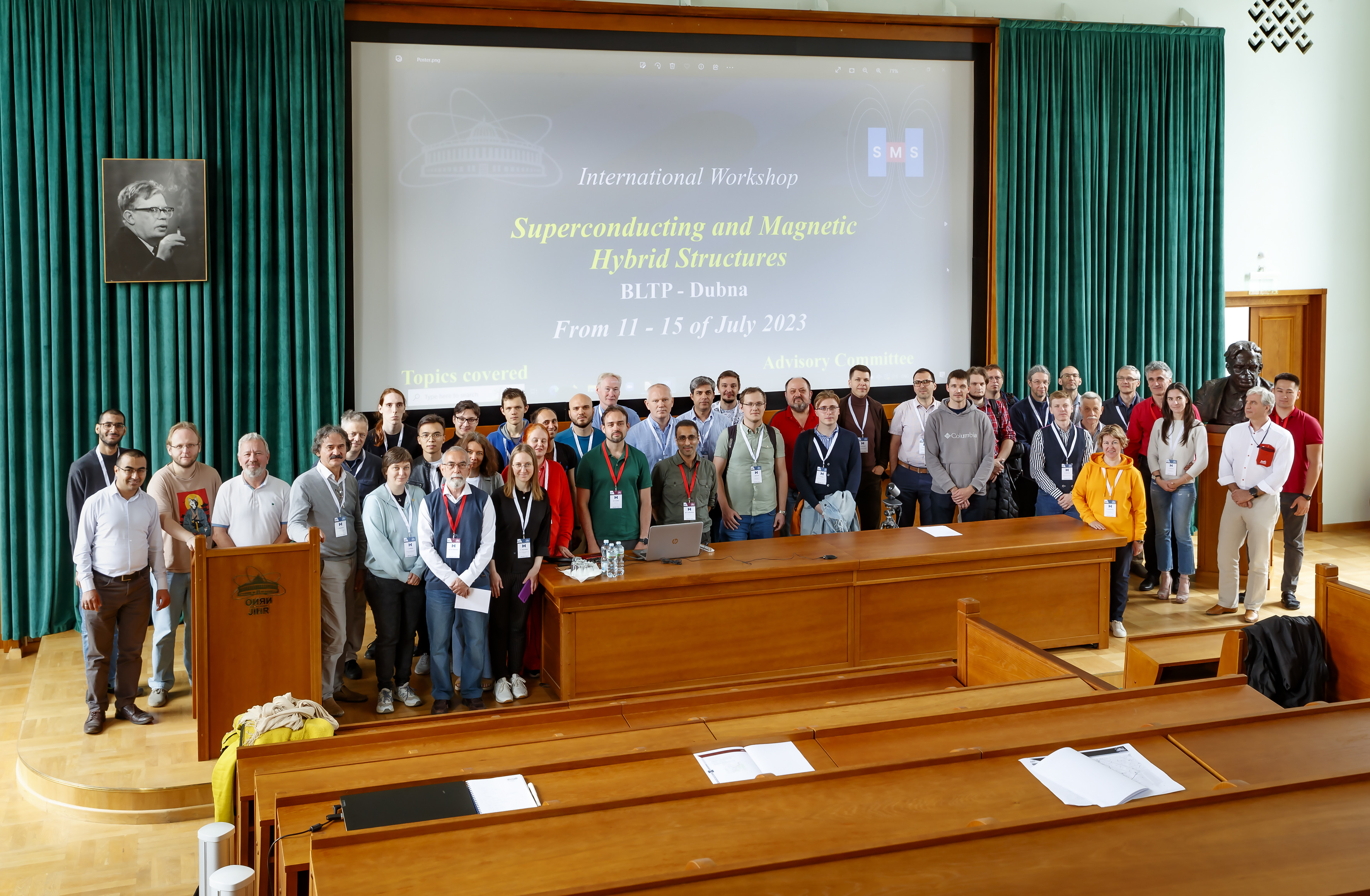Research by JINR theoretical physicists contributes to creation of spintronic devices
News, 01 September 2023
Scientists of the Laboratory of Theoretical Physics of JINR during 2017-2022 carried out a number of studies devoted to the anomalous Josephson effect, a phenomenon occurring in structures of the superconductor-ferromagnetic-superconductor type (SFS). The scientific group of BLTP theorists discovered a number of previously unknown properties manifested in these materials, developed some techniques to control the magnetization of magnetic materials, and also proposed a way to radically reduce energy consumption in the functioning of spintronic devices. Some theoretical models derived in the Laboratory of Theoretical Physics are awaiting experimental verification by their colleagues from the JINR Laboratory of Neutron Physics.
 Authors: Yuri Shukrinov (in the centre), Kirill Kulikov, Majed Nashaat, Andrey Mazanik, Ilhom Rahmonov
Authors: Yuri Shukrinov (in the centre), Kirill Kulikov, Majed Nashaat, Andrey Mazanik, Ilhom Rahmonov
The Josephson effect was predicted by American physicist Brian Josephson in 1962, soon after which it was confirmed experimentally. The effect is based on the tunnelling of coupled electrons through a barrier. If a non-superconducting material of very small thickness, for example, nano-sized, is located between two layers of a superconductor, the superconducting current will pass through this material – this phenomenon is called the Josephson effect. If the interlayer is a ferromagnetic, i.e. a material that is magnetised in the absence of an external magnetic field, then the anomalous Josephson effect is said to be present. While Josephson effect reflects the superconducting phenomenon, the anomalous effect links two antagonistic phenomena – superconductivity and magnetism, which until recently could not be combined, since the magnetic field destroys superconductivity, and superconductivity pushes out the magnetic field.
“In hybrid Josephson structures, they managed to bring them closer together, which allows superconductivity to control magnetism, and magnetism to influence superconductivity. Figuratively speaking, it was possible to “get them married”, and this “marriage” became the basis of a new field of science: superconductor spintronics”, – said the leading researcher of the Laboratory of Theoretical Physics of JINR Yury Shukrinov. In order to realize this interaction, it was needed to break two symmetries in the hybrid S/F structure: the symmetry of inversion (of spatial coordinates) and the symmetry with respect to time reversal. Time reversal is a speculative operation when -t is substituted into the corresponding equation instead of the parameter t. If these two symmetries are broken in ferromagnetics, one of the manifestations of new properties for S/F structures will be a change in the current-phase relation, where superconducting current turns out to be coupled with magnetic moment. “This model was called φ0-Josephson junction, it implements the coupling of the superconducting current, or, more specifically, the superconducting phase, with the magnetic moment of the ferromagnet,” commented Yury Shukrinov.
 Illustration of the system under consideration, with equivalent electrical circuit diagram. The nanomagnet is located at a distance a from the center of the weak coupling of the Josephson junction
Illustration of the system under consideration, with equivalent electrical circuit diagram. The nanomagnet is located at a distance a from the center of the weak coupling of the Josephson junction
Josephson effect finds enormous applications in various fields of science, technology, and medicine. In particular, devices on its basis are used in superconductor electronics for measuring ultraweak magnetic fields, in quantum metrology as modern volt standards, in medicine for taking brain magnetoencephalograms. The Josephson effect is one of the bases for the generation and detection of coherent electromagnetic radiation in the terahertz frequency region. The terahertz region of the electromagnetic spectrum is located between the infrared and microwave regions of the electromagnetic wave scale and is the least studied to date. In addition to Josephson structures, terahertz radiation can be obtained using free electron lasers, one of them is planned to be built at the LINAC-200 acceleration facility at JINR. While the laser will be able to produce powerful radiation necessary for scientific experiments, the system of coupled Josephson junctions is more compact and promising for wide application. The terahertz range is used for example in fields including astronomy, medicine, security systems and environmental monitoring. “If you have a system of coupled Josephson junctions, the power in it grows in proportion to the square of the number of junctions. The constraint on the resulting power is the magnitude of the current – too much current can cause samples to overheat. At the level of 400 Josephson junctions the power is about one milliwatt, which is enough for practical applications. There are already developments of these kind of devices to produce terahertz radiation, mainly in Japan and the United States,” said Yury Shukrinov.
In Europe, using the research of JINR BLTP scientists, the recognized experts in the field of superconductor spintronics Claudio Guarcello and Sebastian Bergeret proposed an innovative cryogenic memory element (C. Guarcello and F.S. Bergeret, A cryogenic memory element based on an anomalous Josephson junction, Phys.Rev.Appl, 13, 034012, 2020). It was based on the method of magnetic moment reversal in Josephson structures discovered by Yuri Shukrinov’s group [20]. BLTP scientists developed the technique and demonstrated magnetic moment reversal by a superconducting current pulse, which leads to a drastic reduction of power consumption in a spintronic device operation.
Later, JINR theorists found analytical criteria for magnetic moment reversal in structures of different types [7,8], found periodicity in the occurrence of reversal intervals when changing the parameters of spin-orbit coupling and Gilbert damping, as well as the ratio of Josephson energy to magnetic energy [15].
The second goal of the research, in addition to reducing energy consumption, was the development of fundamentally new methods of magnetisation control, which was also achieved. In addition, the manifestation of the properties of the Kapitsa pendulum in the anomalous Josephson junction and the indirect locking of magnetic precession by Josephson oscillations under the action of an external periodic signal were predicted.
These and other results are reported by the authors themselves.
 Authors of the study at the International workshop “Superconducting and Magnetic Hybrid Structures” at the BLTP JINR
Authors of the study at the International workshop “Superconducting and Magnetic Hybrid Structures” at the BLTP JINR
 At the workshop, which was dedicated to structures with the anomalous Josephson effect, the main results of the described studies were presented
At the workshop, which was dedicated to structures with the anomalous Josephson effect, the main results of the described studies were presented
Authors of the study at the International Workshop “Superconducting and Magnetic Hybrid Structures” in BLTP JINR Key results of the described studies were presented at the meeting, which was devoted to structures with anomalous Josephson effect. “One of the methods of magnetization control was found in a detailed study of phase dynamics and volt-ampere characteristics in structures with anomalous Josephson effect. We have discovered a new effect – the manifestation of the properties of Kapitza’s pendulum (the appearance of dynamically stable positions of magnetization) in the anomalous Josephson junction (AJJ) [19, 20], as well as in the system “Josephson junction – nanomagnet” (JJ-NM) [4,14], opening the possibility of reorientation of the easy axis of a ferromagnet. What makes this method unique is that it makes it possible to change the orientation of magnetization and the position of stability points due to the applied high-frequency periodic influence and opens a new way to control magnetization by means of superconducting current.
We have also found a new method for controlling the dynamics of magnetic precession. The capability of controlling the dynamics of magnetic precession by a superconducting current provides a wide scope for applications in superconductor electronics and spintronics. In our work [2], we demonstrated for the first time the indirect locking of magnetic precession in the SFS junction by Josephson oscillations under the action of an external periodic signal, which is reflected by the appearance of synchronization steps on the magnetization-current dependence through the junction. The position of the step is determined by the emission frequency and the shape of the resonance curve.
Another interesting effect is the manifestation of a negative differential resistance (NDR) state on the current-voltage characteristic of the AJJ. These states can be used in switching circuits and multivibrator electronic devices. We have shown that in the region with NDR an additional step appears on the current-voltage characteristic. Detailed studies [2] have shown that oscillations corresponding to this step have the same frequency as oscillations on the first step, but they have a different amplitude. This allows us to control not only the frequency but also the amplitude of magnetic precession in the capture region. There arise unique perspectives for controlling and manipulating the dynamics of magnetic moment in that kind of hybrid systems.
We have obtained a number of other interesting effects arising in hybrid nanostructures. In particular, it was demonstrated that new dynamically stable magnetization positions can lead to the splitting of the easy axis of a ferromagnet in SFS Josephson junctions on the surface of a three-dimensional topological insulator [13]. It was shown that such splitting leads to the stabilization of an unconventional fourfold degenerate ferromagnetic state. It was also shown that the voltage at the junction is related to the change of the magnetization component, which allowed us to propose a mechanism for the electrical control of the magnetization in the SFS junction on the surface of a 3D topological insulator.
The most important characteristic of a Josephson structure measured experimentally is its current-voltage characteristic. In this regard, it has been investigated in sufficient detail. We have discovered subharmonic staircase structures on the current-voltage characteristics due to the influence of magnetization dynamics on the phase difference in the Josephson junction [10,16-18]. The structures can be used in various fields of superconductor spintronics. They are sensitive to changes in periodicity in the dynamics of the system and can serve as an indicator of various exotic states. In particular, they can be used to register Majorana bound states in Josephson nanostructures.
The development of methods to control and manage chaos is one of the most important challenges in the field of data coding and improving communication security. We have shown a rich variety of periodic and chaotic behavior in the dynamics of the magnetic moment in the JJ-NM system [3]. It has also been shown that the chaotic behavior of the system can be controlled by applying an external periodic signal of the desired frequency and amplitude. It is assumed that such a system can be used as chaotic logic gates in computers based on chaotic systems.
Some important results have been obtained in the study of resonance properties of hybrid nanostructures. In SFS structures [11,12] and the JJ-NM system [15], we have demonstrated a shift of the resonance frequency caused by the interaction of the magnetic subsystem with the Josephson junction. The results obtained are of great practical significance. It is well known that one of the methods for characterization of magnetic systems is ferromagnetic resonance (FMR). The standard FMR theory based on microwave absorption in magnetic materials shows that the resonant frequency is a function of the effective field, material and system parameters. This dependence can be used to determine the parameters of the material. Alternatively, these parameters can be varied to control the microwave absorption properties of the material. This two-sided relationship between the FMR characteristics and the physical parameters of the system is usually based on analytical expressions that give the resonant frequency as a function of the material parameters (anisotropy constants, exchange and dipole couplings). For hybrid structures, however, such analytical expressions cannot be obtained and one has to resort to numerical modelling or some approximate solution. Our results provide necessary information for the estimation of physical parameters in hybrid structures of SFS and JJ-NM type.
Interesting results were obtained in the study of FMR in hybrid structures of superconductors with a ferromagnet [1,9]. A variety of regular dynamical states of magnetization along the current-voltage characteristic of the anomalous Josephson junction characterized by specific phase trajectories has been demonstrated [12]. We have shown that they can be controlled, in particular, it was shown that external electromagnetic radiation allows us to fix a specific trajectory within the Shapiro step.
The nonlinear properties of hybrid structures were clearly manifested in the effect of anomalous dependence of the resonance frequency on the Gilbert damping parameter [6]. This dependence was named α-effect and explained in [5,6]. It has been demonstrated that the coupled Landau-Lifshitz-Gilbert-Josephson system of equations can be reduced to a scalar nonlinear Duffing equation. We have shown that there is a critical value of damping at which the cubic nonlinearity comes into play, changing the dependence of the resonance frequency on the damping leading to this dependence. A demonstration of the α-effect at different values of the spin-orbit interaction and the ratio of the Josephson energy to the magnetic energy is given in our paper [5]. We have found a formula predicting the critical value of the damping as a function of the spin-orbit coupling and the ratio of the Josephson energy to the magnetic energy”.
The series of works performed in 2017-2022 on the topic “Anomalous Josephson Effect” was awarded the first JINR-2022 Prize in the competition of research theoretical works (authors: Yuri Shukrinov, Ilhom Rahmonov, Kirill Kulikov, Majed Nashaat, Andrey Mazanik). The second JINR-2022 prize in the category “For Research Experimental Works” was awarded to LNP scientists with research devoted to the magnetism of ferromagnetic-superconducting inhomogeneous layered structures, which are also related to the anomalous Josephson effect. Two teams of scientists in the same field, theorists and experimentalists, have come together and will pursue collaborations on this topic. “We have drawn up big plans for the experimental realization of our achievements and expect to get their experimental confirmation,” said Yury Shukrinov. For this purpose, in addition to the main methods of studying superconducting ferromagnetic heterostructures, LNP scientists will also measure the current-voltage characteristics of the samples. It is planned that Vladimir Zhaketov, a researcher in the neutron optics sector of FLNP, will carry out the measurements at MIPT in collaboration with a group of scientist Valery Ryazanov of the Institute of Solid State Physics of the Russian Academy of Sciences (Chernogolovka).
List of publications
- Шукринов Ю. М. Аномальный эффект Джозефсона, УФН 192 345–385 (2022).
- S. A. Abdelmoneim, Yu. M. Shukrinov, K. V. Kulikov, H. ElSamman, and M. Nashaat. Locking of magnetization and Josephson oscillations at ferromagnetic resonance in a φ0 junction under external radiation, Phys. Rev. B 106, 014505 (2022).
- M. Nashaat, M. Sameh, A. E. Botha, K. V. Kulikov, Yu. M. Shukrinov. Bifurcation structure and chaos in nanomagnet coupled to Josephson junction, Chaos 32, 093142 (2022).
- K. V. Kulikov, D. V. Anghel, A. T. Preda, M. Nashaat, M. Sameh, Yu. M. Shukrinov. Kapitsa pendulum effects in a Josephson junction coupled to a nanomagnet under external periodic drive, Phys. Rev. B 105, 094421 (2022).
- А. Janalizadeh, I. R. Rahmonov, S. A. Abdelmoneim, Yu. M. Shukrinov and M. R. Kolahchi. Nonlinear features of the superconductor–ferromagnet–superconductor φ0 Josephson junction in the ferromagnetic resonance region, Beilstein J. Nanotechnology 13, 1155–1166 (2022)
- Yu. M. Shukrinov, I. R. Rahmonov, A. Janalizadeh, and M. R. Kolahchi. Anomalous Gilbert damping and Duffing features of the superconductor-ferromagnet-superconductor φ0 Josephson junction, Phys. Rev. B 104, 224511 (2021).
- I. V. Bobkova , A. M. Bobkov, I. R. Rahmonov, A. A. Mazanik , K. Sengupta, and Yu. M. Shukrinov. Magnetization reversal in superconductor/insulating ferromagnet/ superconductor Josephson junctions on a three-dimensional topological insulator, Phys. Rev. B 102, 134505 (2020).
- A. A. Mazanik, I.R. Rahmonov, A.E. Botha, and Yu. M. Shukrinov, Analytical criteria for magnetization reversal in a φ0 Josephson junction, Phys. Rev. Applied 14, 014003 (2020).
- Yu. M. Shukrinov, I. R. Rahmonov, and A. E. Botha. Peculiarities of IV characteristics and magnetization dynamics in the φ0 Josephson junction, Low Temp. Phys. 46, 932 (2020).
- M. Nashaat and Yu. M. Shukrinov, Ferromagnetic resonance and effect of supercurrent on the magnetization dynamics in S/F/S junctions under circularly polarized magnetic field, Phys. Part. Nuclei. 17 (1), 7984 (2020).
- Y.M. Shukrinov, and I.R. Rahmonov, Resonance Properties of the Josephson Junctions with Ferromagnets, Phys. Part. Nuclei. 51, 816822 (2020).
- Yu. M. Shukrinov, I. R. Rahmonov, and K. Sengupta, Ferromagnetic resonance and magnetic precessions in Phi-0 junctions, Phys. Rev. B 99, 224513 (2019).
- M. Nashaat, I. V. Bobkova, A. M. Bobkov, Yu. M. Shukrinov, I. R. Rahmonov, and K. Sengupta. Electrical control of magnetization in superconductor/ ferromagnet/ superconductor junctions on a three-dimensional topological insulator, Phys. Rev. B 100, 054506 (2019).
- Yu. M. Shukrinov, M. Nashaat, I. R. Rahmonov, and K. V. Kulikov, Ferromagnetic resonance and the dynamics of the magnetic moment in a Josephson junction – nanomagnet system, JETP Letters 110 (3), 160–165 (2019).
- П. Х. Атанасова, С. A. Панайотова, И. Р. Рахмонов, Ю. M. Шукринов, E. В. Земляная, M. В. Башашин. Periodicity in the Appearance of Intervals of the Reversal of the Magnetic Moment of a ϕ0 Josephson Junction, Письма в ЖЭТФ, 110, 736 (2019).
- M. Nashaat, Yu. M. Shukrinov, A. Irie, A. Y. Ellithi, and Th. M. El Sherbini, 16- Microwave induced tunable subharmonic steps in superconductor–ferromagnet–superconductor Josephson junction, Low Temp. Phys. 45, 1246 (2019).
- Yu. M. Shukrinov, I. R. Rahmonov, and A. E. Botha. Superconducting Spintronics in the presence of spin-orbital coupling, IEEE Transactions on Applied Superconductivity, 28 (7), 1800505 (2018).
- M. Nashaat, A. E. Botha, and Yu. M. Shukrinov. Devil’s staircases in the IV characteristics of SFS Josephson junctions, Phys. Rev. B 97, 224514 (2018).
- Yu. M. Shukrinov, A. Mazanik, I. R. Rahmonov, A. E. Botha and A. Buzdin. Re-orientation of easy axis in φ0 junction, EPL. 122, 370012 (2018).
- Yu. M. Shukrinov, I. R. Rahmonov, K. Sengupta, and A. Buzdin, Magnetization reversal by superconducting current in Josephson junctions, Appl. Phys. Lett. 110, 182407 (2017).